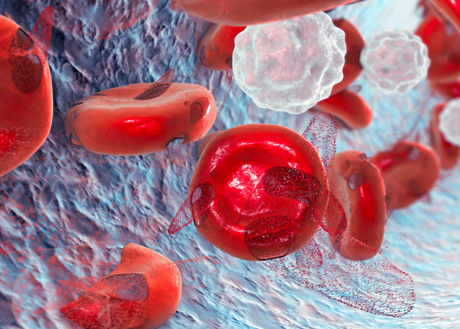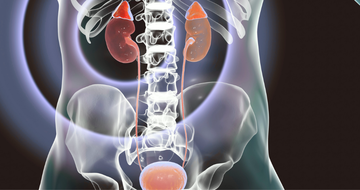Taking COMMAND(S) of Myelodysplastic Syndrome Related Anemia Management with Luspatercept-aamt
Background
Myelodysplastic Syndromes (MDS) are a group of heterogeneous disorders characterized by abnormal development and dysfunction of hematopoietic stem cells. These disorders cause bone marrow dysplasia which impacts normal hematopoiesis, subsequently leading to anemia, neutropenia and/or thrombocytopenia.1 Patients with MDS are generally older, with a median age of approximately 70 years, and this disorder primarily affects more men than women. The incidence of MDS in the general population is approximately 4.5 per 100,000 people each year; however, this incidence increases to 26.9 per 100,000 people per year in individuals 70 years of age and older.2
Major issues associated with MDS are related to morbidities caused by cytopenias such as infection risk, need for frequent blood transfusions, and an increased risk of transformation to acute myeloid leukemia (AML).1 MDS risk stratification is categorized based on the Revised International Prognostic Scoring System (IPSS-R) which categorizes patients based on cytogenetics; percentage of blasts in bone marrow; hemoglobin; platelets and absolute neutrophil count. The lower the score on IPSS-R, the longer the median overall survival and decreased risk of transformation to AML. Very-low, and low-risk MDS management is focused on disease-related symptom management as well as low doses of chemotherapy or immunosuppression. Patients with Intermediate-, high- and very-high-risk disease are recommended to be evaluated for allogeneic transplantation which will help determine what route of treatment is appropriate based on patient-specific characteristics (i.e. indefinite hypomethylating agent or consideration for allogeneic transplant).3
Patients with MDS who are transfusion dependent have significantly shorter overall survival compared to those who are non-transfusion dependent due to risk of iron overload, increased risk of infection, transfusion reactions and/or more severe bone marrow disease. Historically, erythropoiesis-stimulating agents (ESAs) such as epoetin alfa (Procrit, Epogen) and darbepoetin alfa (Aranesp) have been utilized as the standard of care for treatment of anemia in patients with an erythropoietin level <500 to alleviate the need for frequent blood transfusions. However, some patients fail to respond to ESAs, and the duration of response is limited in patients who do respond.4
Luspatercept-aamt (Reblozyl) works by binding to and inhibiting activity of transforming growth factor-beta (TGF-B), which acts as a negative regulator of late-stage erythropoiesis. By inhibiting TGF-B signaling, luspatercept-aamt promotes erythrocyte maturation. Luspatercept-aam is administered as a subcutaneous injection every 3 weeks. The dose may be titrated based on hemoglobin response and need for blood transfusions between doses. Side effects associated with luspatercept-aamt include: thrombosis/thromboembolism, hypertension, fatigue, dyspnea, diarrhea, nausea, and peripheral edema.5
Luspatercept-aamt is a category 1 recommendation per National Comprehensive Cancer Network (NCCN) guidelines for low-to-intermediate-risk MDS in patients with ring sideroblasts >15% without SF3B1 mutation (or ring sideroblasts >5% in patients with an SF3B1 mutation).3 Furthermore, the results from the phase III COMMANDS trial presented at the American Society of Clinical Oncology (ASCO) annual meeting offer a novel treatment option with luspatercept-aamt (Reblozyl) in patients with low-to-intermediate-risk MDS associated anemia who are blood transfusion dependent and ESA-naive regardless of ring sideroblasts.6
COMMANDS
The COMMANDS study was a phase 3, open-label, multicenter, randomized controlled trial. Patients were eligible for enrollment if they were 18 years or older, diagnosed with very low risk, low risk or intermediate risk MDS, ESA-naïve, and requiring red blood cell transfusions. Patients were randomly assigned in a 1:1 ratio to luspatercept-aamt or epoetin alfa. The randomization was stratified based on patients' baseline need for red blood cell transfusions defined as <4 units per 8 weeks vs. >4 units per 8 weeks; erythropoietin concentrations defined as <200 U/L vs. >200 to <500 U/L; and presence (or absence) of ring sideroblasts. Luspatercept was administered every 3 weeks starting at 1 mg/kg with the possibility of titrating up to 1.75 mg/kg based on response. Epoetin alfa was administered weekly starting at 450 IU/kg with the possibility of titrating up to 1050 IU/kg (maximum dose of 80,000 IU) based on response. The primary endpoint was red blood cell transfusion independence (RBC-TI) for at least 12 weeks while concurrently increasing mean hemoglobin by at least 1.5 g/dL. The primary endpoints were assessed in an intention-to-treat population, and safety assessments were conducted in all patients who received at least one dose of the study treatment. Secondary endpoints included erythroid response of at least 8 weeks during weeks 1-24 of the study, RBC-TI of at least 12 weeks or more, and RBC-TI for 24 weeks or more. 7
A total of 356 patients were randomized from January 2019 to August 2022 to receive luspatercept-aamt (n=178) or epoetin alfa (n=178). Median age was 74 years with a slight male predominance 56% (n=198). An interim efficacy analysis was conducted in October 2022 for 301 patients, of which 147 were in the luspatercept-aamt group and the remaining 154 received epoetin alfa. Eighty-six out of 147 patients in the luspatercept-aamt arm (58.5%) while 48 out of 154 patients in the epoetin alfa arm (31.2%) reached the primary endpoint of RBC-TI for at least 12 consecutive weeks while concurrently increasing the mean hemoglobin by >1.5 g/dL (common risk difference on response rate 26.6; 95% CI 15.8-37.4; p<0.0001). 7
For the secondary endpoint, the authors found 74.1% (n=109) of patients in the investigational arm vs. 51.3% (n=79) of patients receiving epoetin alfa achieved an erythroid response increase of at least 8 weeks (p<0.0001). RBC-TI for at least 12 weeks was achieved by 66.7% (n=98) of patients receiving luspatercept-aamt and 46.1% (n=71) of patients receiving epoetin alfa (p=0.0003). RBC-TI of at least 24 weeks was achieved by 47.6% (n=70) of patients who received luspatercept-aamt and 29.2% (n=45) of patients who received epoetin alfa (p=0.0012). Exposure to treatment was longer in patients who received luspatercept-aamt compared to epoetin alfa (42 weeks [IQR 20-73 weeks] vs. 27 weeks [19-55 weeks]). The most common treatment-related adverse effects observed in >3% (maximum 5%) of the luspatercept-aamt arm were fatigue, dyspnea, nausea, headache, and hypertension. No side effects were observed in >3% of patients in the epoetin alfa cohort.7
Discussion
The results of the COMMANDS trial with luspatercept-aamt demonstrated longer duration of response and longer RBC-TI vs. epoetin-alfa in the overall population; however, patients responded differently depending on presence of ring sideroblasts. In ring sideroblast-positive patients, the primary endpoint was achieved in 65% of patients on luspatercept-aamt compared to 26% on epoetin alfa. In ring sideroblast-negative patients, 46% achieved the primary endpoint on epoetin compared to 41% on luspatercept-aamt. Luspatercept-aamt demonstrated a longer median duration of RBC-TI (126 weeks vs. 77 weeks on epoetin-alfa); however, this trend was not consistent with patients who were ring sideroblast-negative. Patients who were ring sideroblast-positive achieved a median duration of RBC-TI of 121 weeks on luspatercept-aamt compared to 47 weeks on the ESA. For patients without ring sideroblasts, luspatercept-aamt did not demonstrate significant improvement in median duration of RBC-TI compared to ESA.7
Treatment-related adverse effects were observed in both treatment arms; however, the incidence was relatively low. Although the incidence was low, more adverse effects were observed in the luspatercept-aamt arm compared to the ESA arm. In addition, there was no statistically significant difference in grade 3 or 4 adverse events between the two treatment groups. More patients who received epoetin alfa discontinued or withdrew treatment compared to luspatercept-aamt (105 vs. 78). An important difference to consider is the distinct administration schedule of each medication. Epoetin alfa is given on a weekly schedule compared to every 21 days with luspatercept-aamt. It is not clear at this time why epoetin alfa was selected as the comparative agent over longer acting darbepoetin alfa which may be administered every 14 days in MDS.5
Anemia associated with MDS has significant implications on a patient’s quality of life and morbidity. The interim results of the COMMANDS trial offer patients with very low-to-intermediate-risk MDS with an additional treatment option that has demonstrated longer duration of response compared to the current standard of care.7 Based on the interim analysis of this trial, luspatercept-aamt received a new FDA-labeled indication and a category 1 recommendation from NCCN for the treatment of anemia in adult patients with ESA-naive, very low-to-intermediate-risk MDS who require regular red blood cell transfusions.4,5 Long-term follow-up and additional data is needed in order to confirm the interim results and further delineate findings in other patient subgroups such as lower-risk myelodysplastic syndrome, specifically patients who are non-mutated SF3B1 or ring sideroblast-negative.
Citations:
1.Sekeres MA, Taylor J. Diagnosis and Treatment of Myelodysplastic Syndromes. JAMA. 2022;328(9):872. doi:https://doi.org/10.1001/jama.2022.14578
2.Surveillance, Epidemiology, and End Results Program (SEER). National Cancer Institute. seer.cancer.gov. Published 2023. https://seer.cancer.gov/statistics-network/explorer/application.html
3.Greenberg PL, Stone RM. NCCN Clinical Practice Guidelines in Oncology - Myelodysplastic Syndromes. National Comprehensive Cancer Network. 2023;(Version 2.2023). https://www.nccn.org/professionals/physician_gls/pdf/mds.pdf
4.Mukherjee S, Zimmerman KM, Gaijra K, et al. Real-world Erythropoiesis-stimulating Agent (ESA) Treatment Patterns and Outcomes among U.S. Patients with Lower-risk Myelodysplastic Syndromes (LR-MDS). Journal of Clinical Oncology. 2022;40(16_suppl):e19065-e19065. doi:https://doi.org/10.1200/jco.2022.40.16_suppl.e19065
5.Reblozyl (Luspatercept-aamt) Package Insert. Food and Drug Administration; 2019. https://www.accessdata.fda.gov/drugsatfda_docs/label/2019/761136lbl.pdf
6.Garcia-Manero G, Platzbecker U, Santini V, et al. Efficacy and safety results from the COMMANDS trial: A phase 3 study evaluating luspatercept vs epoetin alfa in erythropoiesis-stimulating agent (ESA)-naive transfusion-dependent (TD) patients (pts) with lower-risk myelodysplastic syndromes (LR-MDS). Journal of Clinical Oncology. 2023;41(16_suppl):7003-7003. doi:https://doi.org/10.1200/jco.2023.41.16_suppl.7003
7.Platzbecker U, Della Porta MG, Santini V. Efficacy and Safety of Luspatercept versus Epoetin Alfa in Erythropoiesis-stimulating Agent-naive, Transfusion-dependent, Lower-risk Myelodysplastic Syndromes (COMMANDS): Interim Analysis of a Phase 3, Open-label, Randomised Controlled Trial. The Lancet. 2023;402(10399):373-385. doi:https://doi.org/10.1016/S0140-6736(23)00874-7



